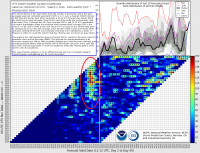I'd be hesitant in getting too concerned this early since Nino springs are climatologically late starters in the Plains with much of their activity concentrated in May and June (often due to the sub tropical jet suppressing moisture southward early in the season).
It's early in the season, very early. We've been "spoiled" with a near climo (at times, seemingly above climo) severe pace thus far in 2016. It's likely to quiet down for a time in early April, which is not unusual, whatsoever. I'm still optimistic about late April, but we'll see how things go. I am not worried about drought conditions right now in the High Plains either. It's a relatively small area in a short-term drought. The abundance of moisture in East Texas and the lower Mississippi Valley over the past month or so should offset any "dry" concerns. If anything, perhaps this works to sharpen the dryline, and/or favor more LP events, as opposed to HP.
I'm not necessarily a big fan of El Niño analogs for this April, as the results and similarities are mixed. I had trouble correlating the late winter pattern in this El Niño with other notable El Niño winters and there seems to be a lot variability. (I have a more optimistic look at the month based on what I've seen) 2008 has been a decent analog for a number of reasons.
- The upper air pattern we've seen over the past few weeks. (Only caveat/setback is the eastern Canada/Great Lakes troughing progged for early April 2016, while 2008 basically flipped into a spring pattern quickly, with only a short-lived eastern NA trough around 4/12-16)
- March 2008 was also dry across the southern Rockies/High Plains with very steady severe activity from February through part of June.
- Expectation that eastern U.S. ridging returns during the second half of April 2016.
- The Euro weeklies have been very consistent in flipping the pattern by mid-April.
- Although less reliable, the CFS tends to agree.
One could also point toward 2011 and 2012 for active early fire weather seasons that coincided with big severe events in April. I tend to favor an April that starts slow and then sees a fairly steady stream of potential events from weeks 2-5. Essentially, I think it is more likely that we see several small-moderate events, as opposed to one particularly major outbreak.
Back with the analogs...the troughing pattern projected for early April is flagging several analogs with 1990. That April was below average for tornadoes, but saw active months in May and June, along with the Ohio Valley outbreak in early June. That was a weak El Niño winter, but seems like another plausible scenario
The bottom line is that I see a lot of mixed signals, however, the evidence tends to point toward an at or above average spring, especially later in the season, as opposed to the beginning. It may not be scientific, but we've also seen several over-performing events this year and a nearly steady stream of threats on a weekly basis since late June.
The only seasons with more tornadoes YTD through March 22 over the past 11 years are 2002 and 2006-08. We're in good company... I think this may be the year to finally break the post-2011 doldrums. I also doubt that this spring dies as suddenly as 2012 did.

